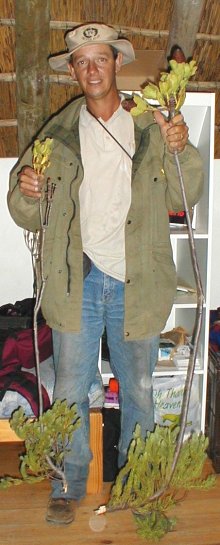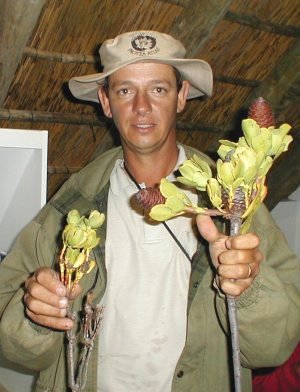
Home
Mission
Overview of Project
Project Staff
Sponsors
Achievements
Checking, Illustrations
Upcoming Activities
Id and Species Lists
Protea Information
Protea Gallery
Growing Proteas
Interim Dist. Maps
Publications
Afrikaanse Inligting
![]()
New Conebush Discovered by Atlassers

 Protea atlassers
have discovered a new species of Conebush at their last Annual get-together in the
Riviersonderend Mountains. This is the eighth new species
of protea discovered since the Protea Atlas Project began.
Protea atlassers
have discovered a new species of Conebush at their last Annual get-together in the
Riviersonderend Mountains. This is the eighth new species
of protea discovered since the Protea Atlas Project began.
The new Conebush (Climax Conebush - Leucadendron nova), belonging to the genus Leucadendron, is unusual in having a low mat-like bush of vegetative branches bearing narrow leaves, from which arise 2 m-tall reproductive stems with round leaves on the top. In the female plants these stems bear large cones in which the seeds are stored for release after a fire. It is closely related to the Ridge-Cone Conebush - Leucadendron comosum, but this is a conventional protea with normal branches each bearing a single cone.
The plants were discovered by Dr Tony Rebelo of the National Botanical Institute, on the north slopes of Olifantsberg above Villiersdorp, while exploring underatlassed areas on the Riviersonderend. Dr Rebelo noted: "I first saw them about half a kilometre away whilst scanning the area with binoculars. I had no idea that they were proteas - they looked like a bunch of lollipops on the ridge. It was only when I got there, that I realized they were Conebushes. They had to be new - there is nothing in the protea family like them! What a fitting way to end off the final Annual Get-together of the Protea Atlas Project! We had over 40 atlassers walking the slopes. It was pure chance that I happened upon them first. We knew that the area was the richest in the country for protea species - the true heart of the Cape Floral Kingdom. But we were not expecting a new species so late in the project." Fellow atlasser Nigel Forshaw, who received a cell call from the excited discoverers, remarked "He went the extra mile. He deserved to get it." Other atlassers waited anxiously at the Theewaterskloof base to catch a glimpse of the new species, while he and two mountaineers, Bill Turner and Ivor Jardine, commenced the four hour descent from the site. Di Turner of the "Outramps" - an atlassing team from George - was delighted "There are still new species in these mountains. The project is not finished yet by a long way." The previous species to have been discovered by atlassers was a Spiderhead near Napier in July 1998, which was named Serruria rebeloi after Dr Rebelo.
Dr John Rourke, protea taxonomist at the Compton Herbarium, Kirstenbosch confirmed that the plant was both new and unique. Only 16 plants were seen in a single patch. Much of the area burned in December, so it is possible that there are more populations on the north slopes of the range. Nevertheless, this is one of the rarest of the Conebushes.
The Protea Atlas Project has been running for almost ten years and came to an end on the 31 March 2001. Over 470 atlassers contributed almost a quarter million records of proteas from 55000 localities in southern Africa. The next phase is the analysis of the data, which will involve teams from South Africa and the United States exploring the data using Bayesian Statistical Models and Geographical Information Systems to explain the patterns of species distributions. Already the data have been used by the Cape Action Plan for the Environment to plan reserve areas and conservation priorities, and by conservation scientists at the National Botanical Institute exploring the effects of global warming on our flora.
The one that did not get away

Dr Tony Rebelo with the new Conebush which he discovered in the Riviersonderend Mountains.
Have a look at more about the Climax Conebush.
A press cutting from that appeared in the Cape Argus in April, 2001
Back Protea Atlas Project
